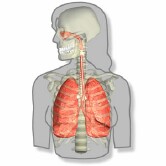
WEDNESDAY, May 22 (HealthDay News) — Physicians weighing the benefits and risks of CT scans for detecting lung cancer now have more information to help with the decision. A new analysis of a 2010 U.S. study finds that low-dose CT scans pick up significantly more lung tumors than chest X-rays do.
People with a long history of smoking are at high risk for lung cancer, the deadliest form of cancer in the United States. But doctors have to consider the potential harm of radiation exposure when ordering screening. The initial 2010 trial suggested that the low-dose CT scans can save lives, but they’re not yet routine and insurers typically don’t pay for them.
“There’s a whole bunch of stuff that has to be worked out,” said Dr. Norman Edelman, chief medical officer of the American Lung Association. This includes the prospect of expanding screening to a wider group and relying on radiologists less experienced than those who reviewed the lung scans in the initial study.
Already, some medical centers are offering CT lung scans below cost, at $200 or $300, apparently in the hope that they’ll recoup their loss by detecting suspicious nodules in the lungs of patients, he said.
About 158,000 people die from lung cancer in the United States each year, often because it’s detected too late for effective treatment. The new analysis of the 2010 study indicated that by identifying malignancies sooner, low-dose CT scans will reduce the death tally.
Who should get screened is a question that must be addressed, said Dr. Otis Brawley, chief medical officer and executive vice president of the American Cancer Society. “Everyone wants to jump toward screening as an answer,” Brawley said.
The initial study involved 53,000 current and former heavy smokers, aged 55 to 74, who underwent a CT scan or chest X-ray every year for three years, starting in 2002.
By 2010, the death rate among those who got the CT scans was 20 percent lower than for those who got X-rays.
CT scans revealed potential signs of cancer in 27 percent of those scanned, compared to 9 percent of people who got X-rays, the researchers found. In both groups, about 91 percent had at least one more test.
Most of those suspicious spots and nodules weren’t actually cancerous.
After follow-up, lung cancer was diagnosed in 1.1 percent of the patients in the CT group and 0.7 percent of the X-ray group, the researchers reported in the May 23 issue of the New England Journal of Medicine.
The CT scans were much more likely to pick up lung cancer in its early, more treatable stages: stage 1 cancer was found in 158 CT scan patients versus 70 X-ray patients, according to the study.
Brawley said, however, that screening comes with a price, and not just the cost of the scans, which can be expensive. About 1 percent of cancers are thought to be caused by radiation used in medicine, he said. That raises the prospect that some people will develop cancer because they’ve been scanned for it.
Patients may still decide that cancer screening is appropriate, Brawley said. “We support those who understand the benefits and risks and want to get screened,” he said.
“[However], stopping smoking still provides a lot more bang for the buck,” he said. “Don’t look to lung cancer screening as a great Shangri-La.”
Preliminary research presented Tuesday at the American Thoracic Society meeting in Philadelphia found that in a smaller group of smokers and former smokers, 6 percent who underwent low-dose CT scans had lung cancer detected.
More information
For more about lung cancer, see the U.S. National Library of Medicine.

